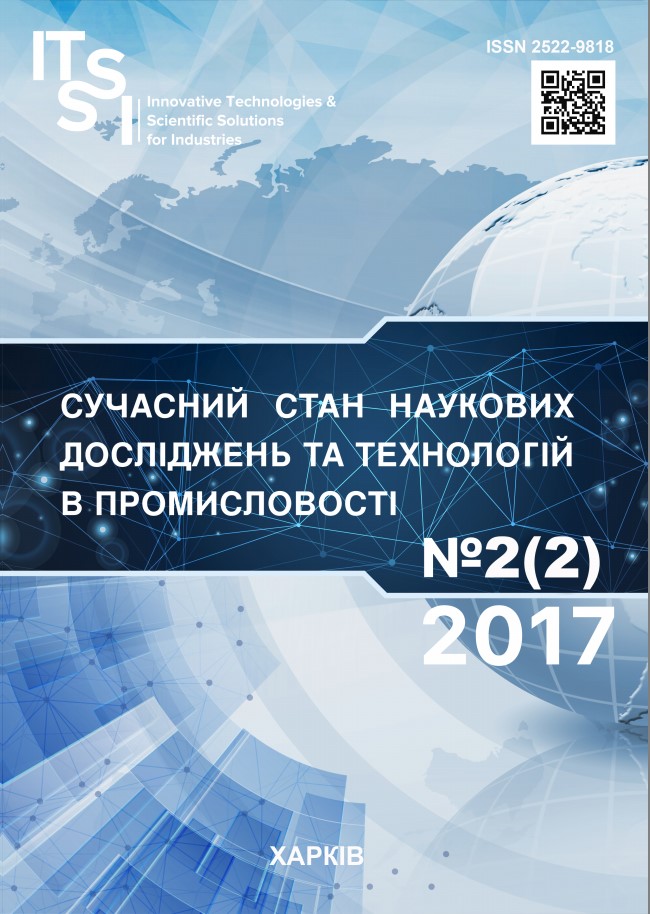ОСНОВНІ ПРИНЦИПИ КОМПЛЕКСНОГО УПРАВЛІННЯ СКЛАДАЛЬНО-РІЗЬБОУТВОРЮЮЧИМ ПРОЦЕСОМ
DOI:
https://doi.org/10.30837/2522-9818.2017.2.077Ключові слова:
складання, кріпильні елементи, різьбоутворюючий процес, крутний моментАнотація
Предметом дослідження в даній статті є питання, пов’язані з комплексним управлінням операціями зборки кріпильно-різьбоутворюючих елементів на всіх етапах їх здійснення. Мета – розробка узагальненої структури інформаційно-керуючої системи складально-різьбоутворюючим процесом. Завдання: обґрунтування принципів управління складально-різьбоутворюючі процесом на кожному з етапів реалізації збірки для підвищення ефективності даних операцій, досліджувати силові, точності і експлуатаційно-технічні характеристики з’єднань і зробити висновок про ефективність пропонованої теорії управління складанням. Отримані наступні результати. У статті представлені аналітичні залежності силових показників різьбоутворення при складанні в корпус і лист, в тому числі і зусилля затяжки з’єднання, проаналізовано збірка багатошарового пакета різнорідних листових матеріалів. На основі теоретичного аналізу отримано залежності силових показників різьбоутворення при складанні в корпусний і листовий матеріал. Досліджено збірку пакета листових матеріалів, включаючи багатошаровий пакет з різнорідних матеріалів типу "метал-пластмаса". Висновки. Досліджено процес складання різьбових з’єднань з використання принципів управління, які дозволяють підвищити ефективність складального процесу, знизити трудомісткість основних операцій, поліпшити якість одержуваних сполук. Для зниження крутять моментів запропоновано використовувати адаптивне управління швидкістю загвинчування на основних переходах різьбоутворення. Розроблено технологію отримання різьбових з’єднань із заданими властивостями, визначені основні шляхи підвищення ефективності складально-різьбоутворюючих процесів на основі комплексної системи управління складальним процесом.
Посилання
Butkin, N. S. (1974), Investigation of interchangeability, manufacturability and quality of smooth-threaded joints: dissertation [Issledovanie vzaimozamenjaemosti, tehnologichnosti i kachestva gladko-rez'bovyh soedinenij: dis. … Kand. tehn. nauk]. Moscow: MAI. 252 p.
Zelenov, L. M. (1979), "Foreign Fasteners" ["Zarubezhnye krepezhnye izdelija"]. Avtomobil'naja promyshlennost'. No. 8. P. 31-32.
Ivanova, V. M., Kalinina, V. N., Neshumova, L. A. and others (1981), Math statistics [Matematicheskaja statistika]. Moscow: Vyssh. shk. 371 p.
Labeckij, V. M. (1976), Investigation of the process of thread formation and production of threaded joints by means of extruding rods: dissertation [Issledovanie processa formirovanija rez'by i poluchenie rez'bovyh soedinenij s pomoshh'ju vydavlivajushhih sterzhnej: dis. ... kand. tehn. nauk]. Barnaul. API named after I. I. Polzunova. 191 p.
Kolombet, E. A. (1991), Microelectronic means for processing analog signals [Mikrojelektronnye sredstva obrabotki analogovyh signalov]. Moscow: Radio i svjaz'. 376 p.
Novik, F. S., Arsov, A. B. (1980), Optimization of the processes of metal technology by the method of planning experiments [Optimizacija processov tehnologii metallov metodom planirovanija jeksperimentov]. Moscow: Mashinostroenie. Sofija. Tehnika. 304 p.
John, R., Jones, S. (1997), "The economic Relevance of materials joining technology". Welding World. Vol. 39. No. 3. P. 145-153.
Huhnert, T. (1995), "Systems for determining the coefficient of friction as the most important quality feature of screw mounting" ["Systeme zur Ermittlung des Reibwertes als wichtigstes Qualitätsmerkmal der Schraubmontage"]. Machine. No. 6-7. P. 30-31.
"Right for the job: Advertising company Taumel Assembly Systems (NJ)". Automation. March. 1990. Vol. 3. P. 56.
"Inserts to repair a variety of thread sizes". Modern machine Shop. 1997. Vol. 70. No. 1. P. 284-287.
##submission.downloads##
Як цитувати
Номер
Розділ
Ліцензія
Авторське право (c) 2018 Anton Skorkin, Oleg Kondratyuk

Ця робота ліцензується відповідно до Creative Commons Attribution-NonCommercial-ShareAlike 4.0 International License.
Наше видання використовує положення про авторські права Creative Commons для журналів відкритого доступу.
Автори, які публікуються у цьому журналі, погоджуються з наступними умовами:
Автори залишають за собою право на авторство своєї роботи та передають журналу право першої публікації цієї роботи на умовах ліцензії Creative Commons Attribution-NonCommercial-ShareAlike 4.0 International License (CC BY-NC-SA 4.0), котра дозволяє іншим особам вільно розповсюджувати опубліковану роботу з обов'язковим посиланням на авторів оригінальної роботи та першу публікацію роботи у цьому журналі.
Автори мають право укладати самостійні додаткові угоди щодо не комерційного та не ексклюзивного розповсюдження роботи у тому вигляді, в якому вона була опублікована цим журналом (наприклад, розміщувати роботу в електронному сховищі установи або публікувати у складі монографії), за умови збереження посилання на першу публікацію роботи у цьому журналі.
Політика журналу дозволяє і заохочує розміщення авторами в мережі Інтернет (наприклад, у сховищах установ або на особистих веб-сайтах) рукопису опублікованої роботи, оскільки це сприяє виникненню продуктивної наукової дискусії та позитивно позначається на оперативності та динаміці цитування опублікованої роботи.














